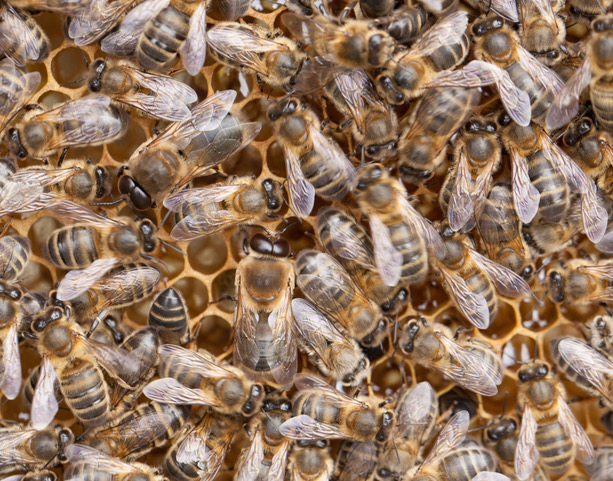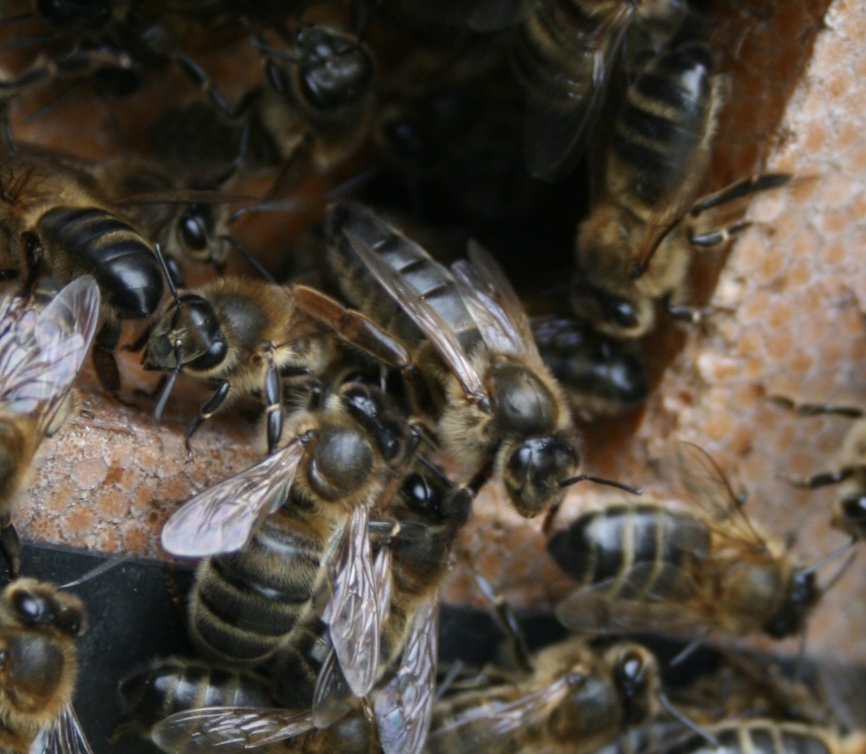Honey bees have been studied for centuries and most of their behaviour is well understood – all the way down to the chemistry of their pheromones and the order of molecules in their DNA. However, one aspect of bee behaviour that remains mysterious is the Drone Congregation Area or DCA.
In this article I hope to pin down some facts about DCAs starting with the fundamental questions:
-
- What
- Who
- Why
- When
- Where
- How
What?
A Drone Congregation Area (DCA) is all about sex.
It is a place up in the air where drones gather together and to which queens are attracted. The drones are in search of sex and the queens are hoping to find suitable genes for their offspring.
Who?
So who are involved?
Drones are male honey bees and on the surface it may seem that their sole purpose is to find a queen and mate with her; they have other roles in the hive but we won’t go into that here.

Interestingly, of all 3 castes – they take the longest to emerge and mature. It would be logical to assume that it takes much longer to reconstruct a drone from the metamorphosal soup than either workers or queens because they are such big chunky chaps. They have those great big, meet-in-the-middle eyes and muscle packed thoraces to enable them to see, and fly long distances. Or for a long time. There is a difference.
Queens
However, virgin queens – which are larger than a worker but smaller than a drone take the least time to mature. But then they are just egg-laying bimbos with pheromones. Or perhaps they are brighter than that.

Virgins are very svelte and streamlined with long wings and when freshly emerged they seem built for action. Only when they are mated and in full lay does long distance flight seem unlikely. But how far do they actually fly?
Why?
Why go to the bother and risk of flying out from the safety of the hive to mate on the wing at the whim of predatory birds and squally summer weather?
Drone congregation areas are an evolved mechanism:
- to avoid inbreeding;
- to ensure the selection of the stongest drones.
Inbreeding
Here is an interesting fact – Gudrun Koeningen and her team (who did much research into this subject) found that if they threw pebbles up into an overhead DCA, drones would form comets to chase the moving object but this chasing behaviour could not be observed outside the DCA.
Something about the DCA seems to switch on this chasing behaviour – and what it leads to – because drones do not seem to be interested in chasing things outside of the DCAs. Nor do they chase virgins round the hive.
A bit like young men at home – they don’t go chasing and mounting their sisters – or their mothers for that matter. Quite apart from the threat of two-headed offspring, the urge doesn’t seem to arise, so to speak.
However, take them away from home and mix them all up together… the boys get competitive and they get horny.
Selection
‘Fitness’ in an evolutionary sense refers to those individuals best fitted to a given environment.
The drone comet is a competition or test evolved to select the strongest and fittest drones from the DCA – the winners get to mate with a queen and pass their genes on to the next generation. Such tests help ensure the survival of the species. Critics of Instrumental Insemination see this as a vital mechanism which is missing in drone selection. They have a point.
When?
Drones leave the hive after lunch on warm sunny days. Gudrun found that temperatures of 25 degrees C or above and when the weather was close, with thunder possible were most favourable.
Where?
Now here’s the crux.
Gudrun Koeniger seemed to have no difficulty finding DCAs in the Alps, given the right sort of weather she knew where to look. Mostly she had the right sort of weather and lo and behold there were DCAs humming overhead. That’s continental Europe for you – large land masses just tend to have more settled predictable weather. Islands in the Atlantic just don’t. In Ireland – the only predictable thing about summer weather is the unpredictability.
To find a DCA – strap a virgin queen to the end of a very long pole then walk her into a likely area. If there is a DCA – a comet of drones will come to her very quickly. Beowulf Cooper used to attend the annual Gormanston Summer Beekeeping Course in Co.Meath, Ireland and would often take to the grounds with a ripe virgin on a stick and locate a DCA there. Students were seldom disappointed – but as you will know if you attend Gormanston on a regular basis – the weather is almost always warm, sunny and dry.
In other parts of Ireland, despite the knowledge that DCAs persist over centuries, in this part of the world and in the the UK DCAs have been more elusive.
The Vicar of Selborne
England’s first Ecologist – Gilbert White, the Vicar of Selborne wrote the ‘Natural History of Selborne’ which was first published in 1789.

In it he described and recorded many observations of the wildlife of Selborne including the presence of what had to be a DCA at Selborne Common:
“There is a natural occurance to be met with upon the highest part of our down on hot summer days, which always amuses me much, without giving me any satisfaction with respect to the cause of it; & that is a loud audible humming of bees in the air, tho’ not one insect is to be seen. This sound is to be heard distinctly the whole common through, from the Money-dells, to Mr White’s avenue-gate. Any person would suppose that a large swarm of bees was in motion, & playing about over his head. This noise was heard last week on June 28th.”
It can still be found today – over 300 years later – but only sometimes! Probably something to do with the weather. To cope with the unpredictability of the weather here in ‘these islands’, the bees have evolved to sieze the moment. They will fly out into the landscape whenever and wherever the temperature, wind, topography and aspect interact to provide the right conditions. DCAs here at the wet end of Europe are moveable feasts.
How does all this work?
Fuel comes into it. A drone fuelling up for a flight can only carry enough nectar to keep him airborne for 25-30 minutes. He cannot fill up from flowers – he has to be fed – so the distance he can fly from home is limited because he has to leave himself enough fuel to get home – in case he doesn’t get lucky and die. The chances of him accomplishing his mission are slim so he has to plan to return home. I should say here – he does no planning – this is behaviour that has evolved over millions of years.
So here if you look at his energy budget this tells us something about the distance a DCA can be from home.
Here are two scenarios:
- Say he flies out 10 minutes and 10 minutes back… that only leaves him 5 to 10 minutes cruising time. That doesn’t make much sense if you bear in mind that his chances of getting lucky are about as good as winning the lottery. Drones need to maximise their time in the DCA.
- Alternatively, if he flies out for only 5 minutes then his return journey is another 5 minutes leaving 15 to 20 minutes cruising around in the DCA waiting for a virgin to pass by. That makes more sense.
So it needs to be close by and if there are thermal currents so much the better – warm updrafts would help keep the drones in the air and conserve energy.
Mating Behaviour Studies in the Austrian Alps
Gudrun Koenigen et al intensively studied DCAs and honey bee mating behaviour in valleys in the Austrian Alps. During the course of their work the team got to know the location of all the DCAs in the study area and also all of the apiaries where bees were kept. They also perfected methods of netting drones within DCAs.
To find the origins of drones in the DCA was relatively easy – they would go to all the apiaries in the morning – open the hives and mark drones – each apiary having a defining colour. Then, in the afternoons they would net drones in DCAs and count drones of each colour. This allowed them to conclude that drones would fly as much as 5km (3 miles) and only downhill (on the outward journey) – in the Alps anyway, drones do not fly uphill and that makes sense really – bearing in mind that honey bees are not creatures of the mountain tops.
In fact that makes sense here too – honey bees are not creatures of the hill so why go there. Assume then that drones fly out and head downhill along a linear feature such as a hedgerow or a stream. Where they go from then on must be evolved guesswork or is it something deeper, more intelligent, something which might explain why it takes so much longer to assemble a drone from the metamorphosal soup.
Who flies furthest, virgin or drone
Various experiments have showed that drones prefer DCAs closest to home but queens prefer the furthest away. So long as all drones and all queens employ the same strategy this is a mechanism which would avoid inbreeding but it raises the following questions.
Q. The queen has to get home but the drone doesn’t, so wouldn’t it make more sense if she chose one closer to home and he went further away?
A. Once the queen enters the DCA of her choice – she is very quickly serviced and can head for home. We know virgins may take a few mating flights so she can go back for another go if need be.
Q. The drone has all the muscle – couldn’t he fly further?
A. Drones may have more muscle but if they choose one closer to home they can stay there for longer.
Q. A virgin must have to pass quite close to DCAs on her journey – might she get jumped?
A. Drones don’t chase virgins outside DCAs and avoiding them might not be so difficult – we know there is a loud humming.
Finding DCAs
So, mark your apiaries on a map and draw 5km circles around them – that will tell you how far your drones will fly. Then look at the contours, think like a drone, fly down a line then follow your imagination.
In this modern world of ours there are things like roads, carparks and ploughed fields. All of them are dark surfaces. The energy of sunlight is reflected from dark surfaces as heat energy and warm air rises in columns from such areas as thermals. Thermals are utilised by hot-air balloons, vultures and hang gliders as an upwards boost against the downward pull of gravity. They are also chosen by drones for congregation areas.
A friend of mine once pointed to an area above a shimmering black carpark near his apiary and said there’s a DCA right there. How do you know says I. Dead drones all over it says he. You have to laugh don’t you?
Roads and carparks stay put but ploughed fields can turn up anywhere. All of these modern features could draw drones away from what might be considered traditional or historic DCA sites and add to the reasons why they seem to be so elusive. An oversupply of thermal sites might also cause a situation where the numbers of drones per DCA are lower than they should be and could be yet another reason why poor queen mating is often such a problem.
There are theories out there that drones are somehow tuned into ‘Ley lines’ and that DCAs are often associated with prehistoric sites such as barrows or standing stones. That’s an exercise bone for the imagination if ever I heard one.
Barrows or standing stones are often on hilltops. Sunlight slanting in on the slope of a little hill can cause thermal columns to rise on a sunny afternoon. But try and imagine how prehistoric man might interpret such areas where, summer after summer, could be heard a loud overhead buzzing accompanied by sprinklings of large dead flies. That’s an exercise bone for the Neolithic imagination to chew on I think and you can imagine how it might result in the erection of large stone or circle of stones to ward off evil.
Click here for more about Drones
Click here for more about the Queen
Click here for more about queen bees
Click here for a free downloadable copy of Gilbert White’s book
Copyright © Beespoke.info 2021. All Rights Reserved.

Great. Thank you. I want to strap a virgin queen to a pole and walk around my area of London!
Really interesting.